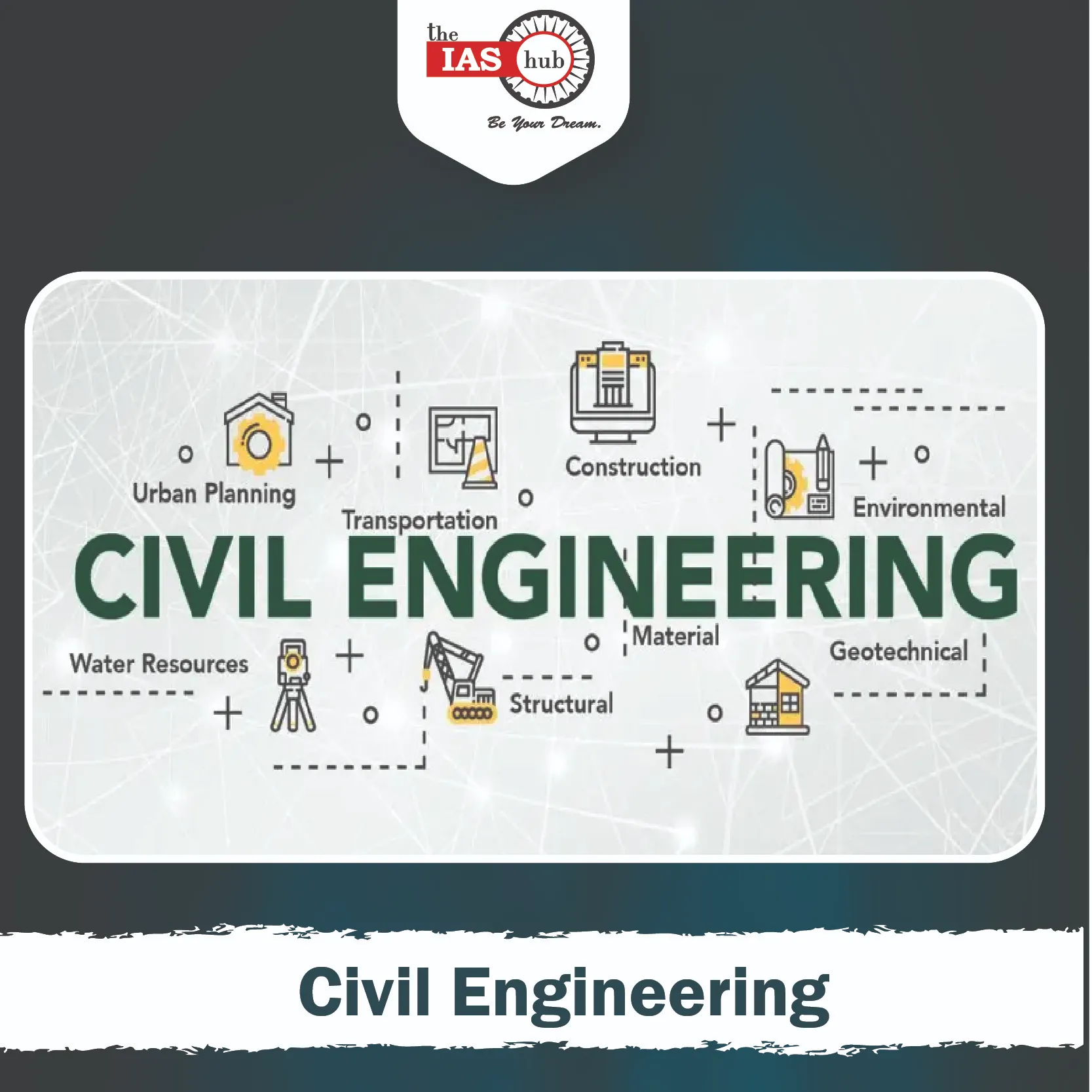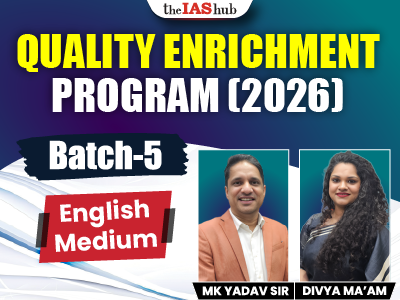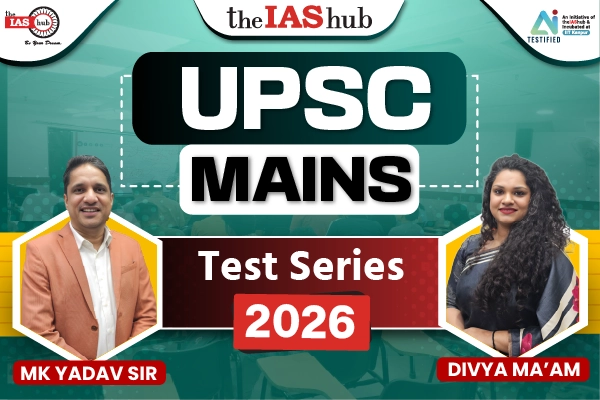"Discover everything you need to know about Civil Engineering optional 2025 for UPSC. Learn about the syllabus, books, notes, topper strategies, and more in this comprehensive guide."


Civil Engineering is one of the most chosen optional subjects for the UPSC Civil Services Examination, especially for candidates with an engineering background. It is a subject that not only helps you understand the technical aspects of infrastructure and construction but also overlaps with the General Studies papers, making it a strategic choice for many aspirants.
In this article, we will cover everything you need to know about Civil Engineering optional, including its syllabus, books, notes, previous year question papers (PYQs), topper strategies, and more. Whether you are a beginner or someone looking to refine your preparation, this guide will help you navigate through the subject with ease.
Here are some reasons why Civil Engineering is a great choice as an optional subject for the UPSC exam:
Civil Engineering optional syllabus is divided into two papers, each covering different aspects of the subject. Here is a brief overview of the syllabus:
| Civil Engineering Optional Syllabus Paper-I | ||
| TOPIC | Sub-Topics | Details |
| 1. Engineering Mechanics, Strength of Materials and Structural Analysis | 1.1 Engineering Mechanics | Units and Dimensions, SI Units, Vectors, Concept of Force, Concept of particle and rigid body. Concurrent, Non-Concurrent and parallel forces in a plane, moment of force, free body diagram, conditions of equilibrium, Principle of virtual work, equivalent force system. First and Second Moment of area, Mass moment of Inertia. Static Friction. |
| Kinematics and Kinetics | Kinematics in Cartesian Coordinates, motion under uniform and non-uniform acceleration, motion under gravity. Kinetics of particle: Momentum and Energy principles, collision of elastic bodies, rotation of rigid bodies. | |
| 1.2 Strength of Materials | Simple Stress and Strain, Elastic constants, axially loaded compression members, Shear force and bending moment, theory of simple bending, Shear Stress distribution across cross sections, Beams of uniform strength. | |
| Deflection of beams: Mecaulay’s method, Mohr’s Moment area method, Conjugate beam method, unit load method. Torsion of Shafts, Elastic stability of columns, Euler’s, Rankine’s and Secant formulae. | ||
| 1.3 Structural Analysis | Castigliano’s theorems I and II, unit load method, of consistent deformation applied to beams and pin jointed trusses. Slope-deflection, moment distribution. | |
| Rolling loads and Influence lines: Influence lines for Shear Force and Bending moment at a section of a beam. Criteria for maximum shear force and bending Moment in beams traversed by a system of moving loads. Influence lines for simply supported plane pin jointed trusses. | ||
| Arches: Three hinged, two hinged and fixed arches, rib shortening and temperature effects. | ||
| Matrix methods of analysis: Force method and displacement method of analysis of indeterminate beams and rigid frames. | ||
| Plastic Analysis of beams and frames: Theory of plastic bending, plastic analysis, statical method, Mechanism method. | ||
| Unsymmetrical bending: Moment of inertia, product of inertia, position of Neutral Axis and Principal axes, calculation of bending stresses. | ||
| 2. Design of Structures: Steel, Concrete and Masonry Structures | 2.1 Structural Steel Design | Structural steel: Factors of safety and load factors. Riveted, bolted and welded joints and connections. Design of tension and compression members, beams of built-up section, riveted and welded plate girders, gantry girders, stanchions with battens and lacings. |
| 2.2 Design of Concrete and Masonry Structures | Concept of mix design. Reinforced Concrete: Working Stress and Limit State method of design—Recommendations of I.S. codes. Design of one-way and two-way slabs, staircase slabs, simple and continuous beams of rectangular, T and L sections. Compression members under direct load with or without eccentricity. Cantilever and Counterfort type retaining walls. | |
| Water tanks: Design requirements for Rectangular and circular tanks resting on ground. | ||
| Prestressed Concrete: Methods and systems of prestressing, anchorages, Analysis and design of sections for flexure based on working stress, loss of prestress. | ||
| Design of brick masonry as per I.S. Codes. | ||
| 3. Fluid Mechanics, Open Channel Flow and Hydraulic Machines | 3.1 Fluid Mechanics | Fluid properties and their role in fluid motion, fluid statics including forces acting on plane and curve surfaces. |
| Kinematics and Dynamics of Fluid flow: Velocity and accelerations, streamlines, equation of continuity, irrotational and rotational flow, velocity potential and stream functions. Continuity, momentum, energy equation, Navier Stokes equation, Euler’s equation of motion, application to fluid flow problems, pipe flow, sluice gates, weirs. | ||
| 3.2 Dimensional Analysis and Similitude | Buckingham’s Pi-theorem, dimensionless parameters. | |
| 3.3 Laminar Flow | Laminar flow between parallel, stationary and moving plates, flow through tube. | |
| 3.4 Boundary Layer | Laminar and turbulent boundary layer on a flat plate, laminar sub-layer, smooth and rough boundaries, drag and lift. | |
| Turbulent flow through pipes: Characteristics of turbulent flow, velocity distribution and variation of pipe friction factor, hydraulic grade line and total energy line. | ||
| 3.5 Open Channel Flow | Uniform and non-uniform flows, momentum and energy correction factors, specific energy and specific force, critical depth, rapidly varied flow, hydraulic jump, gradually varied flow, classification of surface profiles, control section, step method of integration of varied flow equation. | |
| 3.6 Hydraulic Machines and Hydropower | Hydraulic turbines, types classification, Choice of turbines performance parameters, controls, characteristics, specific speed. Principles of hydropower development. | |
| 4. Geotechnical Engineering | Geotechnical Engineering | Soil Type and Structure—gradation and particle size distribution—consistency limits. Water in soil—capillary and structural—effective stress and pore water pressure—permeability concept—field and laboratory determination of permeability—Seepage pressure—quick sand conditions—Shear strength determination—Mohr Coulomb concept. |
| Compaction of soil—Laboratory and field test. | ||
| Compressibility and consolidation concept—consolidation theory—consolidation settlement analysis. Earth pressure theory and analysis for retaining walls, Application for sheet piles and Braced excavation. | ||
| Bearing capacity of soil—approaches for analysis—Field tests—settlement analysis—stability of slope of earth walk. | ||
| Subsurface exploration of soils—methods. | ||
| Foundation—Type and selection criteria for foundation of structures—Design criteria for foundation—Analysis of distribution of stress for footings and pile—pile group action—pile load test. Ground improvement techniques. | ||
| Civil Engineering Optional Syllabus Paper-II | ||
| Section | Topic | Details |
| Construction Technology, Equipment, Planning and Management | 1.1 Construction Technology | Engineering Materials: Physical properties of construction materials with respect to their use in construction—Stones, Bricks and Tiles; Lime, Cement, different types of Mortars and Concrete. Specific use of ferro cement, fibre reinforced C. C., High strength concrete. Timber; Properties defects—common preservation treatments. Use and selection of materials for specific use like Low Cost Housing, Mass Housing, High Rise Buildings. |
| 1.2 Construction | Masonry principles using Brick, stone, Blocks—construction detailing and strength characteristics. Types of plastering, pointing, flooring, roofing and construction features. Common repairs in buildings. Principle of functional planning of building for residents and specific use—Building code provisions. Basic principles of detailed and approximate estimating—specification writing and rate analysis—principles of valuation of real property. Machinery for earthwork, concreting and their specific uses—Factors affecting selection of equipments—operating cost of equipments. | |
| 1.3 Construction Planning and Management | Construction activity—schedules—organization for construction industry—Quality assurance principles. Use Basic principle of network—analysis in form of CPM and PERT—their use in construction monitoring, Cost optimization and resource allocation. Basic principles of Economic analysis and methods. Project profitability—Basic principles of Boot approach to financial planning—simple toll fixation criterions. | |
| 2. Surveying and Transportation Engineering | 2.1 Surveying | Common methods and instruments for distance and angle measurement for CE work—their use in plane table, traverse survey, levelling work, triangulation, contouring and topographical map. Basic principles of photogrammetry and remote sensing. |
| 2.2 Railways Engineering | Permanent way—components, types and their function—Functions and Design constituents of turn and crossing—Necessity of geometric design of track—Design of station and yards. | |
| 2.3 Highway Engineering | Principles of Highway alignments—classification and geometrical design elements and standards for Roads. Pavement structure for flexible and rigid pavements—Design principles and methodology of pavements. Typical construction methods and standards of materials for stabilized soil, WBM, Bituminous works and CC roads. Surface and sub-surface drainage arrangements for roads—culvert structures. Pavement distresses and strengthening by overlays. Traffic surveys and their application in traffic planning—Typical design features for channelized, intersection rotary etc.—signal designs—standard Traffic signs and markings. | |
| 3. Hydrology, Water Resources and Engineering | 3.1 Hydrology | Hydrological cycle, precipitation, evaporation, transpiration, infiltration, overland flow, hydrograph, flood frequency analyses, flood routing through a reservoir, channel flow routing—Muskingam method. |
| 3.2 Ground Water Flow | Specific yield, storage coefficient, coefficient of permeability, confined and unconfined aquifers, aquitards, radial flow into a well under confined and unconfined conditions. | |
| 3.3 Water Resources Engineering | Ground and surface water resources, single and multipurpose projects, storage capacity of reservoirs, reservoir losses, reservoir sedimentation. | |
| 3.4 Irrigation Engineering | (i) Water requirements of crops: consumptive use, duty and delta, irrigation methods and their efficiencies. (ii) Canals: Distribution systems for canal irrigation, canal capacity, canal losses, alignment of main and distributory canals, most efficient section, lined canals, their design, regime theory, critical shear stress, bed load. (iii) Water logging: causes and control, salinity. (iv) Canal structures: Design of head regulators, canal falls, aqueducts, metering flumes and canal outlets. (v) Diversion headwork: Principles and design of weirs on permeable and impermeable foundation, Khosla’s theory, energy dissipation. (vi) Storage works: Types of dams, design, principles of rigid gravity stability analysis. (vii) Spillways: Spillway types, energy dissipation. (viii) River training: Objectives of river training, methods of river training. | |
| 4. Environmental Engineering | 4.1 Water Supply | Predicting demand for water, impurities of water and their significance, physical, chemical and bacteriological analysis, waterborne diseases, standards for potable water. |
| 4.2 Intake of Water | Water treatment: principles of coagulation, flocculation and sedimentation; slow-, rapid-, pressure, filters; chlorination, softening, removal of taste, odour and salinity. | |
| 4.3 Sewerage Systems | Domestic and industrial wastes, storm sewage—separate and combined systems, flow through sewers, design of sewers. | |
| 4.4 Sewage Characterisation | BOD, COD, solids, dissolved oxygen, nitrogen and TOC. Standards of disposal in normal water course and on land. | |
| 4.5 Sewage Treatment | Working principles, units, chambers, sedimentation tank, trickling filters, oxidation ponds, activated sludge process, septic tank, disposal of sludge, recycling of waste water. | |
| 4.6 Solid Waste | Collection and disposal in rural and urban contexts, management of long-term ill-effects. | |
| 5. Environmental Pollution | Sustainable development. Radioactive wastes and disposal. Environmental impact assessment for thermal power plants, mines, river valley projects. Air pollution. Pollution control acts. | |
Choosing the right books is crucial for your preparation. Here are some recommended books for Civil Engineering optional:
Preparing your own notes is one of the best ways to retain information. However, if you are short on time, you can refer to the notes provided by toppers or coaching institutes. Here are some tips for making effective notes:
The Civil Engineering optional question paper is divided into two papers, each carrying 250 marks. The questions are a mix of theoretical and analytical types. Here are some tips for attempting the question paper:
Here is a list of the last five years of Civil Engineering Optional PYQ (Previous Year Question Papers) aspirants can download and use in their preparation.
| UPSC History Optional Previous Year Question Papers | |
| Year | Paper |
| 2024 | Download Paper 1 |
| Download Paper 2 | |
| 2023 | Download Paper 1 |
| Download Paper 2 | |
| 2022 | Download Paper 1 |
| Download Paper 2 | |
| 2021 | Download Paper 1 |
| Download Paper 2 | |
| 2020 | Download Paper 1 |
| Download Paper 2 | |
If you find it challenging to prepare on your own, you can consider joining a coaching institute. Here are some benefits of joining a coaching institute:
Many IAS toppers have chosen Civil Engineering as their optional subject. Here are some tips from toppers:
Civil Engineering is a highly rewarding optional subject for the UPSC exam. With the right strategy, resources, and dedication, you can score well in this subject. Make sure to cover the entire syllabus, practice answer writing, and revise regularly. Use the recommended books, notes, and previous year question papers to enhance your preparation. By following these tips, you can master Civil Engineering and increase your chances of success in the UPSC exam.
Are you preparing for UPSC 2025? Join IAShub’s UPSC coaching batches to boost your preparation. Enroll now!
Some of the best books for Civil Engineering optional are "Strength of Materials by R.K. Bansal," "Structural Analysis by R.C. Hibbeler," and "Design of Concrete Structures by M.L. Gambhir."
To prepare for Civil Engineering optional, understand the syllabus, make a study plan, practice answer writing, and revise regularly. Use recommended books and previous year question papers.
The syllabus for Civil Engineering optional is divided into two papers: Paper-I (Core Civil Engineering Topics) and Paper-II (Applied Civil Engineering Topics).
To write effective answers, structure your answers well, use headings and subheadings, and support your answers with examples. Practice writing answers within the time limit.


Refine your answer writing skills and elevate your UPSC preparation with personalized support and expert feedback.
Fill out the form to get started with the program or any other enquiries !








Are you dreaming of becoming an IAS officer? Then, IAShub can be your best guide. It is one of the Best IAS Coaching in Delhi. Many students who want to clear the UPSC exam join IAShub for learning. The institute gives both online and offline classes. Their teachers are experienced and helpful. They easily explain every topic. Students also get notes, tests, and tips to do well in the exam.
IAShub is in Delhi and is trusted by many UPSC students. It offers coaching for every part of the UPSC exam – Prelims, Mains, and Interview. The classes are simple and easy to understand. The teachers are experts and guide students in the right way. IAShub is also known for its helpful notes, test series, and answer-writing practice. IAShub is the best coaching in Delhi and also gives UPSC Online Classes. This helps students from any place in India to learn. The online classes are live and also recorded. So, students can watch them anytime. These classes cover the full UPSC syllabus.
Here are some important services provided by IAShub:
The UPSC Civil Services Exam has three parts:
This exam is tough, but with the right guidance, it becomes easy to manage. Students must study smart and stay regular.
IAShub supports students from the beginning to the end. It gives the right books, tests, and notes. The classes are easy to follow, and the teachers are always ready to help. Students get personal doubt sessions too. The test series and answer checking help students learn where they need to do better. Also, free study materials save time and money.
IAShub also guides students during the final stage – the interview. Experts take mock interviews and give useful tips. This full support makes IAShub one of the best IAS coaching in Delhi.
